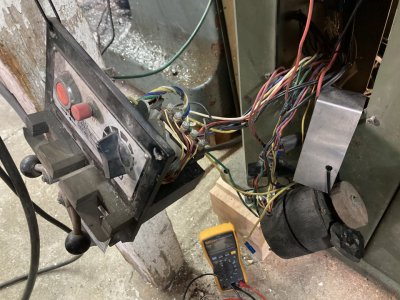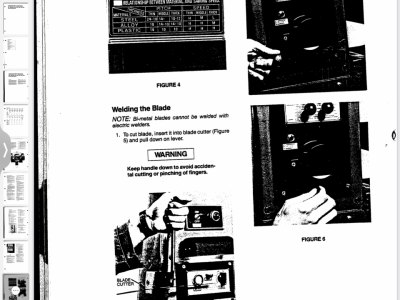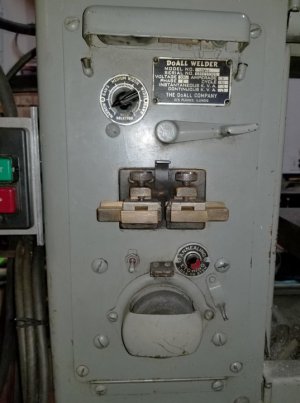- Joined
- Jul 29, 2014
- Messages
- 2,725
I recently added a Jet VBS-900 bandsaw, described in another thread. Noted inop problems were the air pump and the welder/grinder. Everything else seemed to work appropriately, and actually really was quiet and smooth.
I got the pump working by disassembly (destructively, as it turned out), cleaning, making a new main shaft and replacing two bearings, facing the impeller, reassembly and disassembly a few times, then it worked.
The welder is more challenging. The mounting panel for the welder/grinder is broken, and thinking to fix that, I looked inside, here's what came out:

I suspect the welder actually works, but the power came through a bullet connector that was disconnected. And look at that wiring! Could that be factory?? I have seen similar in other Taiwan products from the late 70's...no connectors, everything spliced directly or soldered. I don't have a schematic, but really it's way simpler than all that wire seems to make it.
The grinder motor...the shaft is bent, and while it's a three phase motor, they only use two phases and have a capacitor for the third phase. I suppose the motor probably works too, we'll find out when the new main motor arrives and I can apply power with my phase converter. For some reason a 1/3HP Leeson was installed, and that's being replaced by a 1.5HP. Apparently the saw had a 1HP from the factory.
Also, there is no magnetic starter, just a three pole on/off switch for the main motor, and toggle switches for a grinder light and work light.
I am wondering how much I actually need a blade welder and grinder...any opinions? Also, the blade cutter is missing both jaws.
Still, it was a good deal on what seems to be a terrific bandsaw. And, it's a four speed! With automatic transmission, too!
I got the pump working by disassembly (destructively, as it turned out), cleaning, making a new main shaft and replacing two bearings, facing the impeller, reassembly and disassembly a few times, then it worked.
The welder is more challenging. The mounting panel for the welder/grinder is broken, and thinking to fix that, I looked inside, here's what came out:

I suspect the welder actually works, but the power came through a bullet connector that was disconnected. And look at that wiring! Could that be factory?? I have seen similar in other Taiwan products from the late 70's...no connectors, everything spliced directly or soldered. I don't have a schematic, but really it's way simpler than all that wire seems to make it.
The grinder motor...the shaft is bent, and while it's a three phase motor, they only use two phases and have a capacitor for the third phase. I suppose the motor probably works too, we'll find out when the new main motor arrives and I can apply power with my phase converter. For some reason a 1/3HP Leeson was installed, and that's being replaced by a 1.5HP. Apparently the saw had a 1HP from the factory.
Also, there is no magnetic starter, just a three pole on/off switch for the main motor, and toggle switches for a grinder light and work light.
I am wondering how much I actually need a blade welder and grinder...any opinions? Also, the blade cutter is missing both jaws.
Still, it was a good deal on what seems to be a terrific bandsaw. And, it's a four speed! With automatic transmission, too!



